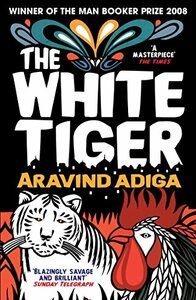Take a photo of a barcode or cover
A compelling dive into Indian class culture and corruption. This is the story of a servant who manages to break out of the Rooster Coop by becoming a "servant, philosopher, entrepreneur and murdered..." as trailered on the back of the book. We know fairly early on who he murders but the actual crime doesn't happen until page 280ish. In the meantime you've got to know something of the victim via Balram's point of view
The structure of the novel is a long letter to the Chinese Prime Minister who is visiting India who has asked to hear from entrepreneurs. Balram gives him a potted life history from school to his current name and business.
It starts off quite light hearted and gets darker as Balram begins to question the Rooster Coop which keeps servants (and all the poor) in line. It is brutal in it's assessment of Indian life and in particular the divide between the rich and the poor / servant classes. It shows that privelge is the problem and not just white privilege. For at least part of the book I had sympathy for his victim as someone trying to break out and help without being able to. He does a good job of not making all privelged people out to be complete monsters.
Balram isn't a saint either although there is a very good parallel between two similar road accidents and their treatment by his old employers and then subsequently him as an employer. That showed him trying to do some good whilst still using the system to his advantage. A nice touch.
The writing is free flowing and (to a Western eye) reads well although as it is written by an American Indian I suspect it may well be unauthentic to a native Indian. I clearly got Balram's voice in my head as I was reading it.
An enjoyable book which I'm glad I've read. Some food for thought about our own actions towards servants.
The structure of the novel is a long letter to the Chinese Prime Minister who is visiting India who has asked to hear from entrepreneurs. Balram gives him a potted life history from school to his current name and business.
It starts off quite light hearted and gets darker as Balram begins to question the Rooster Coop which keeps servants (and all the poor) in line. It is brutal in it's assessment of Indian life and in particular the divide between the rich and the poor / servant classes. It shows that privelge is the problem and not just white privilege. For at least part of the book I had sympathy for his victim as someone trying to break out and help without being able to. He does a good job of not making all privelged people out to be complete monsters.
Balram isn't a saint either although there is a very good parallel between two similar road accidents and their treatment by his old employers and then subsequently him as an employer. That showed him trying to do some good whilst still using the system to his advantage. A nice touch.
The writing is free flowing and (to a Western eye) reads well although as it is written by an American Indian I suspect it may well be unauthentic to a native Indian. I clearly got Balram's voice in my head as I was reading it.
An enjoyable book which I'm glad I've read. Some food for thought about our own actions towards servants.
این کتاب از جمله کتابهایی بود که در کمال لذت، بدون میلی به زمین گذاشتنش، در تک تک لحظات آزادی که داشتم مشغول بلعیدنش بودم. طنزی خفیف، در کنار واقعیتهای دردناک و تاسفبرانگیز جامعهی هندوستان جوری ترکیب شده بود که آدم نمیدونست باید بخنده یا افسوس بخوره.
و من اکثر اوقات افسوس میخوردم.
میزان کثیف بودن سیاست، فقر، گشنگی، تمایل انسانهای برده به برده موندن، زندگی در قفس، و سنتهایی کهنی که خیلی وقتها از ابزارهایی بودند که به محکم کردن پایهی فقر و بدبختی فقرا کمک قابل توجهی میکردند.
یکی از بهترین ویژگیهای این کتاب نثر روان و قدرتمندش بود. نویسنده خیلی ساده حرفهای خودش رو شیوا بیان میکرد، منظور خودش رو با دقت تمام میرسوند و دقیقا میدونست از چه کلماتی استفاده کنه تا کاملا هر مفهوم، هر منظره، هر حس در ذهن ما داغ بشه. و داغ شد، و بعید میدونم حالا حالاها بتونم فراموشش کنم.
به طور خلاصه: جذاب، روان، هوشمندانه و قدرتمند.
و من اکثر اوقات افسوس میخوردم.
میزان کثیف بودن سیاست، فقر، گشنگی، تمایل انسانهای برده به برده موندن، زندگی در قفس، و سنتهایی کهنی که خیلی وقتها از ابزارهایی بودند که به محکم کردن پایهی فقر و بدبختی فقرا کمک قابل توجهی میکردند.
یکی از بهترین ویژگیهای این کتاب نثر روان و قدرتمندش بود. نویسنده خیلی ساده حرفهای خودش رو شیوا بیان میکرد، منظور خودش رو با دقت تمام میرسوند و دقیقا میدونست از چه کلماتی استفاده کنه تا کاملا هر مفهوم، هر منظره، هر حس در ذهن ما داغ بشه. و داغ شد، و بعید میدونم حالا حالاها بتونم فراموشش کنم.
به طور خلاصه: جذاب، روان، هوشمندانه و قدرتمند.
I read this book for class shortly before a trip to India..... It didn't exactly get me very excited about going....
challenging
dark
informative
reflective
tense
medium-paced
Plot or Character Driven:
Character
Strong character development:
Yes
Loveable characters:
No
Diverse cast of characters:
Complicated
Flaws of characters a main focus:
Yes
Listen to the audiobook, but then had to go back and reread the e-book print version to fully understand what I read or listen to. I saw the movie before reading this andbook. The movie, of course abbreviated story. The narrator was excellent in keeping me engaged listening, I would definitely listen to other books read by this narrator.
I have been excited to read this book for years because of all the great reviews. I think the only thing I took from this book is that I never want to visit India.
adventurous
lighthearted
reflective
medium-paced
Plot or Character Driven:
Character
Strong character development:
Yes
Loveable characters:
Yes
Diverse cast of characters:
Yes
Flaws of characters a main focus:
Yes
dark
funny
hopeful
slow-paced
Plot or Character Driven:
Character
Strong character development:
Yes
Loveable characters:
Complicated
Diverse cast of characters:
Yes
Flaws of characters a main focus:
Yes
funny
medium-paced
dark
funny
reflective
medium-paced
Plot or Character Driven:
Character
Strong character development:
No
Loveable characters:
No
Diverse cast of characters:
Yes
Flaws of characters a main focus:
Yes


